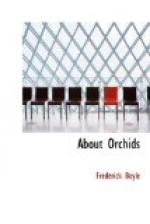V. teres is not such a common object that description would be superfluous. It belongs to the small class of climbing orchids, delighting to sun itself upon the rafters of the hottest stove. If this habit be duly regarded, it is not difficult to flower by any means, though gardeners who do not keep pace with their age still pronounce it a hopeless rebel. Sir Hugh Low tells me that he clothed all the trees round Government House at Pahang with Vanda teres, planting its near relative, V. Hookeri, more exquisite still, if that were possible, in a swampy hollow. His servants might gather a basket of these flowers daily in the season. So the memory of the first President for Pahang will be kept green. A plant rarely seen is V. limbata from the island of Timor—dusky yellow, the tip purple, outlined with white, formed like a shovel.
I may cite a personal reminiscence here, in the hope that some reader may be able to supply what is wanting. In years so far back that they seem to belong to a “previous existence,” I travelled in Borneo, and paid a visit to the antimony-mines of Bidi. The manager, Mr. Bentley, showed me a grand tapong-tree at his door from which he had lately gathered a “blue orchid,”—we were desperately vague about names in the jungle at that day, or in England for that matter. In a note published on my return, I said, “As Mr. Bentley described it, the blossoms hung in an azure garland from the bough, more gracefully than art could design.” This specimen is, I believe, the only one at present known, and both Malays and Dyaks are quite ignorant of such a flower! What was this? There is no question of the facts. Mr. Bentley sent the plant, a large mass to the chairman of the Company, and it reached home in fair condition. I saw the warm letter, enclosing cheque for 100l., in which Mr. Templar acknowledged receipt. But further record I have not been able to discover.




